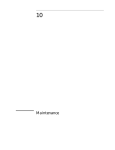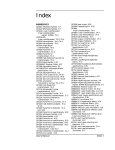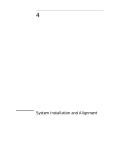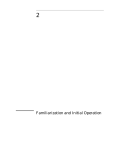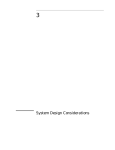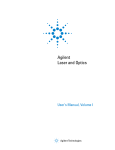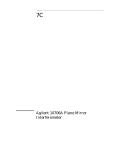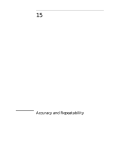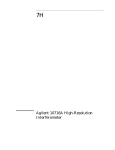Download Chapter 7 Measurement Optics
Transcript
7 Measurement Optics Chapter 7 Measurement Optics General General Each laser measurement system’s measurement axis must have an interferometer and a reflector. Machine design considerations determine which type of interferometer is best. The choice of the interferometer for each axis usually determines the reflector for that axis. This chapter describes the Agilent Technologies measurement optics available for Agilent Technologies laser measurement systems. The first part of this chapter presents material that should be useful to the user of any of the interferometers. Following this introductory material, the chapter is divided into subchapters that describe individual interferometer types, including characteristics and specifications. Table 7-1 lists the measurement optics in order by Agilent Model Number. It also: 1) identifies the subchapter in which each measurement optic is described, 2) provides summary descriptions of the measurement optics, and 3) lists the reflectors and Agilent adjustable optics mounts with which the optics may be used. (The mounts are described in Chapter 9, “Accessories,” of this manual.) Agilent Technologies beam-directing optics are described in Chapter 6, “Beam-Directing Optics,” of this manual. Other Agilent optics that are neither 1) interferometers nor 2) beam-directing optics are described in Chapter 9, “Accessories,” of this manual. 7-2 User’s Manual Chapter 7 Measurement Optics General Table 7-1. Measurement Optics Summary Manual Subchapter Model Number and Name Application Typical System Resolution Beam Separation A Agilent 10702A Linear Interferometer General Purpose λ/64 (10 nm) 12.7 mm (0.5 in) B Agilent 10705A Single Beam Interferometer Low-mass Limited space C Agilent 10706A Plane Mirror Interferometer D Agilent 10706B High Stability Plane Mirror Interferometer E, F Reserved G Config- Reflector uration Reflector Weight Mount Used Straightthrough or Turned Agilent 10703A 42 g (1.5 oz) Agilent 10711A λ/64 (10 nm) Not Applicable (single beam) Straightthrough or Turned Agilent 10704A 10.5 g (0.4 oz) Agilent 10710B Plane Mirror λ/128 (5 nm) 12.7 mm (0.5 in) Straightthrough or Turned Agilent 10724A or user supplied 50 g (1.8 oz) Agilent 10711A Plane Mirror λ/128 (5 nm) 12.7 mm (0.5 in) Straightthrough or Turned Agilent 10724A or user supplied 50 g (1.8 oz) Agilent 10711A Agilent 10715A Differential Interferometer High Accuracy Plane Mirror λ/128 (5 nm) 12.7 mm (0.5 in) Straightthrough or Turned Agilent 10724A or user supplied 50 g (1.8 oz) Agilent 10711A H Agilent 10716A High Resolution Interferometer High Resolution Plane Mirror l/256 (2.5 nm) 12.7 mm (0.5 in) Straightthrough or Turned Agilent 10724A or user supplied 50 g (1.8 oz) Agilent 10711A I Agilent 10717A Wavelength Tracker Wavelength-oflight compensation — Not Applicable Not Applicable Built-in Not Applicable none J Agilent 10719A One-axis Differential Interferometer One Linear Plane Mirror Measurement (Differential) See StraightSpecifications through only custom custom custom See custom custom custom λ/128 (5 nm) or One Angular Measurement K Agilent 10721A Two-axis Differential Interferometer 0.054 arcsec (0.26 µrad) Two Linear Plane Mirror Measurements (Differential) Straight- Specifications through only Linear λ/128 (5 nm) Yaw 0.08 arcsec (0.4 µrad) User’s Manual 7-3 Chapter 7 Measurement Optics General Table 7-1. Measurement Optics Summary (Continued) Manual Subchapter Model Number and Name L, M Reserved N Agilent 10735A Three-axis Interferometer N N O Agilent 10736A Three-axis Interferometer Application 3 Linear Plane Mirror Measurements (Displacement, Typical System Resolution λ/128 (5 nm) Yaw, 0.04 arcsec, (0.2 µrad) Pitch) 0.05 arcsec, (0.24 µrad) 3 Linear Plane Mirror Measurements (Displacement, λ/128 (5 nm) Yaw, 0.04 arcsec, (0.2 µrad) Pitch) 0.05 arcsec, (0.24 µrad) Beam Separation uration Reflector Weight Mount Used Turned Specifications only custom custom custom See Turned Specifications only custom custom custom See Turned Specifications only custom custom custom Plane mirror Customer determined Agilent 10711A 3 Linear Plane Mirror Measurements ( Displacement, Pitch) 0.05 arcsec, (0.24 µrad) Agilent 10737L/R 3 Linear Plane Mirror Measurements (Displacement, See See Specs. Specs. Compact Three-axis Interferometers Reflector See Agilent 10736A- 001 Three-axis Interferometer with Beam Bender λ/128 (5 nm) Config- Turned only or cube corners Yaw, Pitch) P through U Reserved 7-4 User’s Manual Chapter 7 Measurement Optics General Table 7-1. Measurement Optics Summary (Continued) Manual Subchapter Model Number and Name Application A Agilent 10766A Linear Interferometer General Purpose λ/64 (10 nm) 11 mm (0.43 in) V Agilent 10770A Angular Interferometer High Accuracy Plane Mirror λ/64 (10 nm) 11 mm (0.43 in) W, X Reserved Y Agilent 10774A Short Range Straightness Optics High Resolution Plane Mirror — Agilent 10775A Long Range Straightness Optics High Resolution Plane Mirror — Y Typical System Resolution User’s Manual Beam Separation Config- Reflector uration Reflector Weight Mount Used Straightthrough or Turned Agilent 10767A 224 g (0.5 lb) Agilent 10785A — Agilent 10771A 650 g (1.5 lb) Agilent 10785A Not Applicable — Included 800 g (1.8 lb) Agilent 10776A Not Applicable — Included 800 g (1.8 lb) Agilent 10776A 7-5 Chapter 7 Measurement Optics Resolution Resolution The fundamental optical resolution for each interferometer type is listed in Table 7-2. Using electronic resolution extension, the system resolution is increased significantly. Depending on the system, an additional resolution extension factor of 32 is usually available. Table 7-2. Interferometer Resolutions Interferometer Type Fundamental Resolution Linear λ /2 0.316 micron (12.44 microinches) Plane Mirror λ /4 0.158 micron (6.32 microinches) High Resolution Plane Mirror λ /8 0.079 micron (3.12 microinches) Range The nominal optical measurement range for an Agilent laser measurement system is usually 40 meters (130 feet) for the sum of all axes. In calibrator systems, this range may be doubled with the Agilent 5519A/B optional long range kit. The 3 mm diameter beam of the Agilent 5517C-003 Laser Head allows a maximum range of 10 meters (32 feet) for the sum of all axes. Measurement Direction Sense Direction sense depends on the relation of the optical frequencies in the interferometer’s reference and measurement paths. This, in turn, depends on: 1) the orientation of the laser head, 2) the effect of any beam-bending optics in the path between the laser head and the interferometer, and 3) the interferometer's configuration (straight-through or turned). For example, if: 1) f1 (the lower frequency from the laser head) is in the measurement path (that is, the path going to the measurement mirror), and 2) f2 (the higher frequency from the laser head) is in the reference path (that is, the path going to the reference mirror), and 3) the measurement optics are moving away from each other, the fringe counts will be INCREASING. 7-6 User’s Manual Chapter 7 Measurement Optics Measurement Direction Sense Interchanging f1 and f2 will reverse the direction sense, resulting in the fringe counts DECREASING as measurement optics move away from each other. In this manual, “f1” and “f2” have been used to identify the two frequency components of the laser beam. However, because the components that left the laser head having horizontal and vertical orientations can have the opposite orientations when they arrive at an interferometer, “fA” and “fB” are used to identify the beam paths through the interferometers. Figure 7-1 shows how two parallel beams, derived from the same source, can have different polarization orientations at interferometer inputs. An interferometer using one of these beams will produce increasing counts as its measurement mirror moves away from it; an identical interferometer, parallel to the first, but using the second beam, will produce decreasing counts as its measurement mirror moves away. User’s Manual 7-7 Chapter 7 Measurement Optics Measurement Direction Sense VERTICAL AND HORIZONTAL POLARIZATION Notes 1. Shaded ovals represent laser beam cross section (enlarged). 2. V = Vertical Polarization Component. 3. H = Horizontal Polarization Component. 4. fA and fB represent beam paths in Interferometer. V H Beam Splitter V V H H fB H Beam Bender V fA Interferometer V fB H Interferometer fA Figure 7-1. Effect of beam-directing optics on laser beam polarization orientations 7-8 User’s Manual Chapter 7 Measurement Optics Vibration Isolation Vibration Isolation Vibration of the optics along the laser beam can cause the fringe count in the laser measurement system electronics to fluctuate rapidly. Vibrations along this axis constitute real, measurable, displacements; you will have to decide if these fluctuating measurements are acceptable in your application. In extreme cases, however, the velocity of the optics may momentarily exceed the velocity limitation of the laser measurement system, causing an error. When vibration occurs perpendicular to the beam, the beam signal power can fluctuate. If this fluctuation is too great, insufficient beam signal will arrive at the receivers, causing a “measurement signal error.” Loose mounting can cause the optics to move inappropriately during a measurement, causing a measurement error or loss of beam power. Elastic mounting can have the same effect as loose mounting. It can also be responsible for a “sag” offset in the optics’ positions. If there is vibration in the machine, an elastic mounting can transmit and amplify the vibration to the attached optic, possibly causing more errors. You should anticipate these effects and minimize them, if necessary, during the laser measurement system design process. Certain interferometers are inherently less susceptible to vibration effects than others. This is particularly true of differential-style interferometers such as the Agilent 10715A, Agilent 10719A, and Agilent 10721A. The stability of these interferometers is due to the fact that both their reference beams and their measurement beams travel to external mirrors. Any motion of the interferometer itself that is common to both beams will not appear as a measurement. Of course, any vibration between the reference and mirrors will constitute real, measurable, displacements. Fasteners Any optical component that fits an adjustable mount is supplied with mounting screws to mount it on the appropriate adjustable mount. User’s Manual 7-9 Chapter 7 Measurement Optics Vacuum Applications Vacuum Applications Many of the optical components of the laser measurement system have vacuum options, which are compatible with vacuum environments. Contact Agilent Call Center for information (telephone numbers of various call centers are listed on the “Service and Support” page at the back of this manual). Typically, these components have housings made of stainless steel and optical elements attached to the housings using a lower volatility (vacuum-grade) adhesive. See the specifications for a list of materials used in the optics. Use Through Window If the laser beam has to go through a window (for example into a vacuum chamber) the window must meet the following requirements: • A minimum window aperture of 25.4 mm (1 inch) with a minimum thickness of 8 mm (0.3 inch). If a larger window is used, it must be proportionally thicker to assure no distortion in the window when under differential pressures. • Transmitted wavefront distortion less than λ/10 (peak-valley, single-pass) over a 23 mm (0.9 inch) diameter. • Parallelism of faces less than ±2 arc-minutes, to reduce beam steering. • Surface quality 60-40 or better, per Mil-0-13830. • The window must be strain-free. Differential Measurements with Interferometers Several interferometers have the capability to make differential measurements. A differential, measurement is one in which both the reference beam and the measurement beam travel to external mirrors outside the interferometer housing. This allows measurement of the relative positions of the two external mirrors, either or both of which may be moving. Viewed another way, this allows measuring the motion of one reflector relative to a reference datum elsewhere in the machine, external to the interferometer itself. This is unlike the typical interferometer configuration because usually the reference beam path length does not change; in differential configurations, it can. 7-10 User’s Manual Chapter 7 Measurement Optics Differential Measurements with Interferometers One useful example of a differential measurement in a lithography application is for measuring the motion of the X-Y stage relative to the optical column. The Agilent 10719A One-Axis Differential Interferometer and the Agilent 10721A Two-Axis Differential Interferometer are ideally suited to this type of measurement, because they provide parallel reference and measurement paths which are offset vertically by 19 mm (0.750 inch). For such an application, a usersupplied reference plane mirror is required in addition to the measurement reflector on the X-Y stage. Differential measurements that can be made using an Agilent 10719A interferometer are shown in Figure 7J-2. Differential measurements that can be made using an Agilent 10721A interferometer are shown in Figure 7K-2. The Agilent 10715A Differential Interferometer, instead of having an offset spacing as in the Agilent 10719A or Agilent 10721A interferometers, permits the reference beams and the measurement beams to be aligned essentially coaxially. A specially-shaped reference plane mirror (shown in Figure 7G-7) is supplied with the Agilent 10715A. For more information about the Agilent 10715A, see subchapter 7G of this manual. Customized differential configurations are possible with several other interferometers. However, considerable care should be exercised during design and layout to avoid introduction of alignment errors, thermal or mechanical instabilities, and potential deadpath problems. When making differential measurements, both reflectors (reference and measurement) should be of the same type (cube corner or plane mirror); this minimizes thermal drift problems with ambient temperature changes. To use the Agilent 10702A, Agilent 10705A, or Agilent 10766A in a differential configuration, the reference cube corner can simply be detached from the interferometer housing and attached to the reference surface of interest. This is shown in Figure 7A-7 in the Linear Interferometers subchapter (subchapter 7A) of this manual. Be aware that all installation and alignment requirements for the measurement reflector now apply also to the reference reflector. To use the Agilent 10706A or Agilent 10706B interferometer in a differential configuration, a plane mirror is recommended as the reference reflector. Simply replace the reference cube corner (or highstability adapter) with the Agilent 10722A Plane Mirror Converter and attach the reference plane mirror to the reference surface of interest. This is shown in Figure 7C-4 in the plane mirror subchapter (subchapter 7C) of this manual. Again, install and align the reference reflector the same as you would the measurement reflector. User’s Manual 7-11 Chapter 7 Measurement Optics Moving Interferometer Instead of Reflector Moving Interferometer Instead of Reflector When moving the interferometer instead of the measurement reflector is required, the Agilent 10702A-001 (or Agilent 10766A) should be used. In practice, for alignment reasons, these are the only interferometers (except the straightness interferometers) that can be moved while making measurements. For a detailed explanation of why this option is required, see Figure 7A-2 in the Linear Interferometers subchapter (subchapter 7A) of this manual. Product specifications and descriptions in this document subject to change without notice. Copyright (C) 2002 Agilent Technologies Printed in U.S.A. 07/02 This is a chapter from the manual titled: Laser and Optics User's Manual For complete manual, order: Paper version: p/n 05517-90045 CD version: p/n 05517-90063 This chapter is p/n 05517-90107 7-12 User’s Manual












